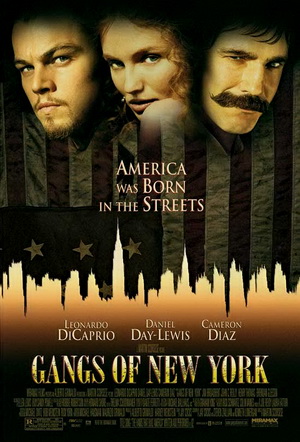Despite the fact that it was nominated for best picture and marked the start of his fantastically successful collaboration with actor Leonardo DiCaprio, Martin Scorsese’s 2002 film Gangs of New York does not have the best reputation. It always seems to be regarded as one of Scorsese’s lesser films and, often times, both The Aviator and The Departed are described as representing a comeback of sorts from Gangs.
To a certain extent, I have to agree. Gangs of New York is a lesser Scorsese movie but then again, a lesser Scorsese film is still a hundred times better than the greatest films from Brett Ratner or Michael Bay.
The flaws of Gangs of New York are many. The film, which tells the epic story of how an Irish gang led by Leonard DiCaprio battled a nativist gang led by Daniel Day-Lewis in Civil War-era New York City, runs for nearly 3 hours and yet it somehow still feels rushed and incomplete. Cameron Diaz is far too contemporary of an actress to be truly believable as a 19th century pickpocket. For that matter, Leonardo DiCaprio gives one of the worst performances of his career, coming across as being one-note and shrill. If you only knew DiCaprio from his work in Gangs of New York, you would have a hard time believing that he was capable of doing the type of work that he did in Inception or The Wolf of Wall Street.
And yet, Gangs of New York is one of those flawed films that I can’t help but enjoy.
First off, on a purely personal level, how can I not love a film about how terribly the Irish were treated in the 19th Century? Seriously, the Irish were regarded as if they were somehow subhuman. They were attacked for being Catholic. They were viewed as being criminals. An entire freaking political party — the American party — was formed specifically to keep the Irish out. But you know what? We Irish kept coming, we kept fighting for our rights, and now everyone wishes they could be one of us!
Secondly, and this should not a shock when you consider that the film was directed by Martin Scorsese, the film looks absolutely gorgeous! Despite the fact that it’s takes place in a 19th century slum and most of the characters are poor, Gangs of New York is a visual feast. I loved the ornate sets and all the colorful clothes. I loved the attention to detail that was put into everything.
(My favorite visual from the film: Daniel Day-Lewis and his entourage walking down a street while fireworks explode directly over Day-Lewis’s shoulder.)
Third, there’s Daniel Day-Lewis’s performance as Bill “The Butcher” Cutting. One reason why DiCaprio’s performance is so noticeably bad is because he’s acting opposite Day-Lewis. Sporting a handle-bar mustache and speaking in an almost satirically exaggerated New York accent, Day-Lewis turns Bill into one cinema’s greatest villains.
Add to that, the great Italian actor Giovanni Lombardo Radice show up for a few minutes, playing Simon Legree in a theatrical production of Uncle Tom’s Cabin! Scorsese should make more films with Radice.
But, perhaps the main reason why I enjoy Gangs of New York is because, as I’ve mentioned so many times in the past, I really am a big history nerd. And Gangs of New York deals with a period in American history that really doesn’t get as much attention as it deserves. While we all know that the Civil War started when the South seceded from the union, what is often forgotten is that the North was not united in their support of Abraham Lincoln and the Union. In fact, the Mayor of New York, Fernando Wood, was such a strong supporter of the Confederacy that he, at one point, suggested that New York City should secede from the union as well. And when Lincoln instituted the draft, NYC — and several other cities in the north — exploded into riots.
Of course, Gangs of New York is not a 100% historically accurate. For one thing, it compresses the time frame of the draft riots and — as films often do — it downplays the culture of Northern racism and instead portrays racists like Bill Cutting as being the exception to the rule. But, even with that in mind, Gangs of New York still serves as a good starting point for those who want to learn more about American history than what they’ve been told in school.
My favorite parts of Gangs of New York dealt not with how the gangs fought each other but instead how the gangs were used as political foot soldiers. One of the major supporting characters in Gangs of New York is William “Boss” Tweed (Jim Broadbent), a real-life politician who was at the center of one of America’s first major political scandals. When we first meet Tweed, he is using Bill Cutting’s gang to fix elections. However, as the film progresses, Tweed comes to realize that the political future of New York rests with the Irish. So, Tweed starts using the Irish gang to fix elections. For those of us who are into political history, the Boss Tweed scenes are a lot of fun.
Gangs of New York has its flaws. It’s the type of project that, if it were made today, it would probably be a series on HBO and it would win all sorts of awards. (Actually, it did kinda. It was called Boardwalk Empire.) It’s not perfect, but I like it.
